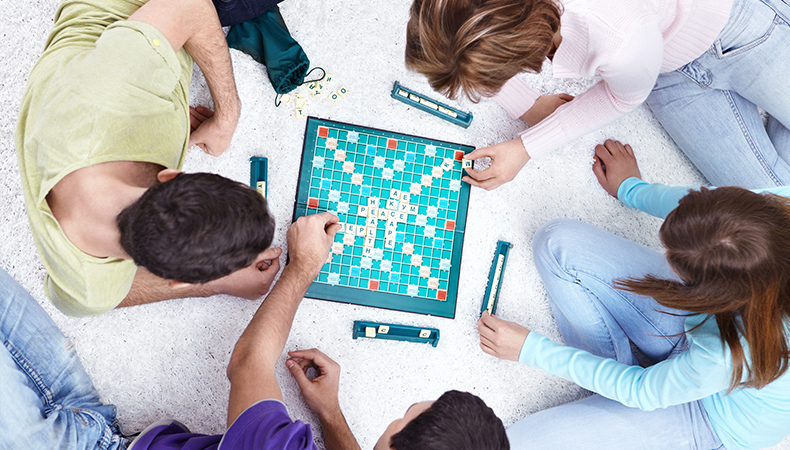
Scrabble was my greatest passion for many years. I played in many national and international tournaments during Middle School and High School. Throughout this time, I was immersed in an intriguing and vibrant community of Scrabble players, where I witnessed the game and its various strategies.
What I found most interesting about the Scrabble world were the types of people who were drawn to the game. The big joke in the Scrabble community is that most of its participants are terrible spellers. Most players care about points and probabilities more than they care about the words themselves. Competitive players learn thousands of obscure words to give themselves an edge without taking any time to learn their meanings. In fact, in many Asian countries such as Thailand and Singapore, where tournament Scrabble is more popular than in America, it is not uncommon for top players to have most of the English dictionary memorized, without being able to speak English.
On every turn in Scrabble, there are 3 main things a player needs to take into consideration when determining the optimal move: the play, the board position, and the leave. The play is the most straightforward; it’s simply the amount of points a player scores. Obviously with all else being equal, more points are better than fewer points. Board positioning is a little more complicated. A Scrabble board exists in a spectrum of being “open” and “closed.” If a board is open, there are many places where players can place words that have a high potential to score points. Open boards have many lanes where bonus squares like the triple letter score or the double word score can be utilized. In closed boards, these bonuses are harder to reach and therefore you can expect that both players will have lower expected scores.
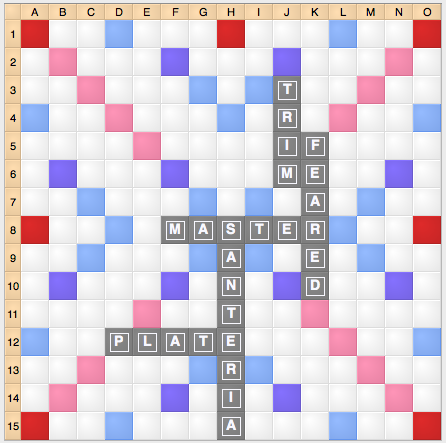
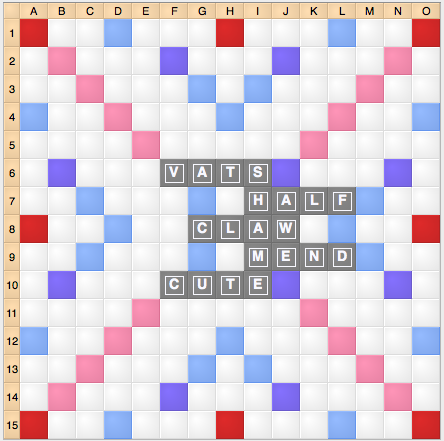
It is a very common strategy for players who are behind to open the board to increase their chances of a comeback, and for players who are ahead to shut down the board and prevent high scoring plays from their opponent to lower the chances of a comeback. In the early game, where the score is generally tighter, players are usually neutral as to whether or not to open the board. The main exception to this is when one player is much stronger than their opponent. Such a player would always want to keep the board open since they are more able to utilize the board’s openness than their opponent.
The leave is the most interesting component of a turn. The leave is the collection of letters a player leaves behind on their rack after the play. These are the letters that they are guaranteed to have on their next turn along with any new letters they draw from the bag. Let’s say a player has the letters AADEIQU to open the game. The word QUAD would score 28 points (with the double word score), but the leave would be AEI. This is a suboptimal play. Since the leave consists of 3 vowels, the player is very likely to face, on their next turn, a rack with too many vowels, making it harder to find good words. A play like AQUA, though it only scores 26 points, might be more attractive since it leaves behind DEI, a better vowel/consonant ratio.
So how many points should a player sacrifice on the play to improve their leave? The answer to this question relies heavily on the phenomenon of bingos. Bingos are when a player makes a word that uses all their letters, usually a seven-letter word using no letters currently on the board, or an eight-letter word using one letter on the board. If a player holds the letters AEGINRT, and the word CAR is on the board, the following boards show examples of a 7-letter and 8-letter bingo that can be played:
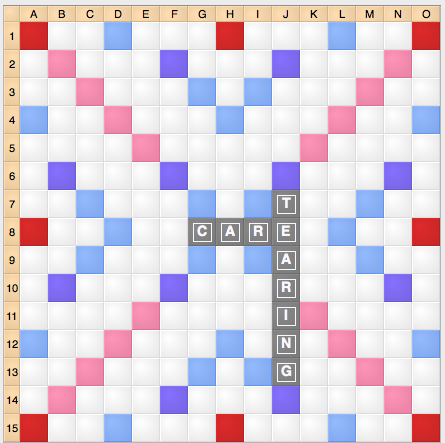
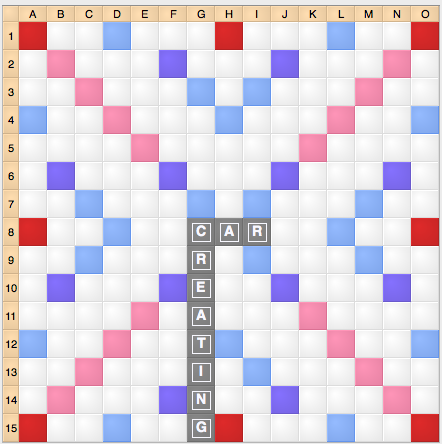
Bingos are important because making one yields a 50-point bonus on top of however many points the play itself scores. Bingos have the potential to drastically change the dynamics of a game. In a typical Scrabble game, the player who makes the most bingos will be the victor the vast majority of the time. A single player making 2 or 3 bingos is very common, and it is not unheard of for a player to make 5 or even 6 bingos in a strong game. In tournament Scrabble, it is rare for a player to not make a single bingo throughout the course of a game, even in games where they lose by a lot.
Despite how common bingos are in tournament play, they are very hard to pull off. Imagine it is the start of the game and you are going first. The chance that you will draw 7 random letters that make a valid English word is roughly 10%. And, many of those valid words are obscure and unknown to the average Scrabble player. For example, if one drew the letters IJLNOQU, even players with strong word knowledge would have a hard time recognizing JONQUIL, a yellow flower. To play a bingo, you must have the letters, know the word, and successfully identify the word in your jumbled rack within the time constraint, hardly an easy task.
The time constraint is a real issue for tournament players. Each player has a total of 25 minutes for their plays in the game. Since the average game goes 12-14 rounds, this means that each player uses 1:30 to 2:00 per round, holding back some time in case they need it for late-game decisions, where they can spend 2:00 to 4:00 for a decision. This is portion of the game where there is much more clarity about what letters remain and how many points are needed to either catch up (when behind) or put the game out of reach (when ahead).
The chances of a player finding a bingo rely heavily on a recognition of probability and letter distributions. Since some letters are more represented in the letter bag than others (12 E’s vs 1 Z), you can learn words that have a higher chance of being drawn. Letters such as E, A, S, T, R, N, I, or the blank tile are considered “bingo prone” because they appear in a high percentage of valid English words, whereas letters such as V, U, Z, X, W, K are bad for bingos. By giving yourself leaves that have a preponderance of bingo prone letters, you can drastically improve your chances of drawing a bingo on the following turn.
Let’s look at an extreme example. Say your leave consists of the letters AEINRT, which spell the word RETINA. If you draw a B, you can make BARINET. C makes CERTAIN, D makes TRAINED, E makes TRAINEE, F makes FAINTER, G makes TEARING, etc. In fact, there are only a handful of letters which do not combine with AEINRT to make a valid 7 letter word. Throughout the game, players track which letters have been played so that they can deduce the letters currently remaining in the bag, and can calculate the probability of drawing a bingo with their leave. This is done on the official score sheet, which has a list of tiles that the players can cross off when they are used. The letters AEINRT are referred to as a ‘stem,’ and there are hundreds of stems that tournament players commonly memorize. Here is a list of common stems for those interested.
Although AEINRT is clearly a good leave, it would be very uncommon to have this leave in a game. Say you had the letters AAEINRT, which does not yield a valid bingo. To guarantee a leave of AEINRT, you would need to only play the letter A. It is very difficult to score a lot by placing only 1 letter on the board. On the other hand, if you played a longer word for more points, like maybe RETINA itself, you would only be leaving A, and you would have a much lower chance of playing a bingo on your next turn. There is a huge tradeoff between scoring high on your play and leaving as many bingo prone letters as possible. In most situations, the best play would be to leave a few bingo prone letters, like ERT or AERT, which give you more flexibility in the play you make now, while improving your bingo chances in the future.
Mastering the optimal tradeoff decision between scoring high and valuable leaves is very difficult, and unlike the words themselves, it cannot be easily studied. There is an astronomical amount of leaves that could arise in a game, and memorizing the bingo potentials of all of them is not feasible. Furthermore, Scrabble games are timed and precise calculations often take too long to execute in practice. Being able to quickly recognize how bingo prone a leave is, and to determine how many points you would be willing to sacrifice in the current play to obtain it, can only be achieved through trial and error over the course of thousands of practice games.
This article only scratches the surface of the richness and complexity of Scrabble strategy and there are many more interesting concepts to explore.

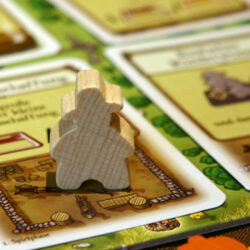
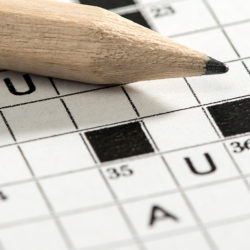
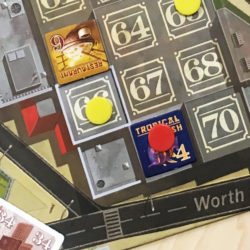
Subscribe Now
Get each new post sent straight to your inbox
We appreciate you taking the time to read our blog and share your feedback. Please be respectful and keep your comments as useful and relevant as possible. We reserve the right to remove comments that contain harassment, offensive language, or are promotional in nature.
Comments are closed.